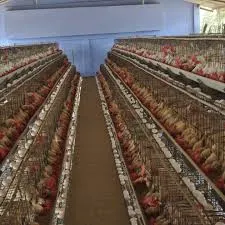poultry broiler cage
Dec . 01, 2024 18:29 Back to list
poultry broiler cage
The Rise of Poultry Broiler Cages A Modern Approach to Efficient Farming
In recent years, the poultry industry has undergone significant transformations due to rising global demands for chicken meat. The broiler segment, responsible for producing fast-growing chickens specifically for meat production, has seen innovations aimed at enhancing efficiency, biosecurity, and welfare. One such innovation is the use of poultry broiler cages, which has sparked debates among industry stakeholders regarding animal welfare, environmental impact, and economic feasibility.
Understanding Poultry Broiler Cages
Poultry broiler cages are specially designed housing systems that allow for the efficient raising of broiler chickens. Unlike traditional floor-based systems, these cages stack chickens in a controlled environment, maximizing space and minimizing the risk of disease. This system replicates several aspects of natural living conditions, such as ventilation and temperature regulation, while providing a controlled setting that can reduce stress on the birds.
These cages can vary in size and complexity, from simple wire constructions to advanced systems equipped with automated feeding, watering, and waste management systems. The primary goal is to create an environment that promotes rapid growth and minimizes the use of resources, turning them into a feasible solution for more significant poultry operations.
Advantages of Using Broiler Cages
1. Space Efficiency One of the primary advantages of poultry broiler cages is their ability to effectively utilize space. By stacking cages vertically, farmers can raise more birds in a smaller footprint, an important consideration in urban areas where land is scarce.
2. Healthier Birds Broiler cages can help improve bird health and biosecurity. By separating individual birds, the spread of diseases is often reduced. Caged environments can be kept cleaner, minimizing the risk of contaminants, parasites, and diseases that thrive in litter systems.
3. Optimized Feeding and Growth With automated feeding systems, birds receive a consistent and balanced diet tailored to their growth requirements. This precision feeding can lead to faster weight gain and reduced time to market, which is advantageous for producers looking to maximize output.
4. Labor Efficiency Modern poultry farming increasingly requires solutions that reduce labor costs. With automated systems for feeding, watering, and cleaning, caged systems can significantly decrease the amount of manpower needed to maintain production levels.
poultry broiler cage

5. Environmental Control Poultry cages facilitate better environmental control, helping to maintain optimal temperature, humidity, and air quality. This controlled environment can further enhance growth rates and reduce mortality.
Concerns and Ethical Considerations
Despite the advantages, poultry broiler cages have raised considerable concerns regarding animal welfare and ethical farming practices. Critics argue that caging birds limits their natural behaviors, such as roaming, foraging, and social interactions. The confinement can lead to stress and discomfort, leading to calls for more humane farming methods.
Additionally, public perception is shifting toward more ethically produced food. Consumer demand for free-range and organic poultry products has risen dramatically, prompting some producers to reconsider their farming methods. Industry stakeholders must balance the operational advantages of caged systems with consumer values and animal welfare considerations.
The Future of Broiler Production
As concerns surrounding animal welfare grow, the poultry industry is at a crossroads. While broiler cages can contribute significantly to productivity and efficiency, the challenge lies in improving the conditions within these systems. This could mean incorporating enrichment features that allow chickens to engage in natural behaviors or transitioning toward hybrid systems that fulfill the needs of both the birds and producers.
Research into alternative housing systems, such as free-range and pasture-based methods, is gaining traction. These methods aim to combine animal welfare with market demands for sustainable products, reflecting a broader trend toward responsible farming practices.
Conclusion
Poultry broiler cages represent a pivotal development in the modern poultry industry, offering numerous efficiencies and advantages. However, as the industry faces growing scrutiny regarding animal welfare and sustainability, there is a pressing need for innovation that respects both the economic realities of production and the ethical considerations of animal husbandry. The future of poultry farming may depend on our ability to adapt to these challenges while balancing productivity with compassionate care for livestock.
-
Automatic Feeding Line System - Anping County Yize Metal Products Co., Ltd.|Pan Feeder Nipple Drinker,Broiler Farming
NewsJul.30,2025
-
Automatic Feeding Line System Pan Feeder Nipple Drinker-Anping County Yize Metal Products Co., Ltd.
NewsJul.30,2025
-
Automatic Feeding Line System-Anping County Yize Metal Products Co., Ltd.|Durable Construction&Easy Maintenance
NewsJul.30,2025
-
Automatic Feeding Line System-Anping County Yize Metal Products Co., Ltd.|Pan Feeder Nipple Drinker&Durable Poultry Farming Solution
NewsJul.30,2025
-
Automatic Feeding Line System Pan Feeder Nipple Drinker|Anping County Yize Metal Products Co., Ltd.
NewsJul.29,2025
-
Automatic Feeding Line System-Pan Feeder Nipple Drinker|Anping County Yize Metal Products Co., Ltd.
NewsJul.29,2025






